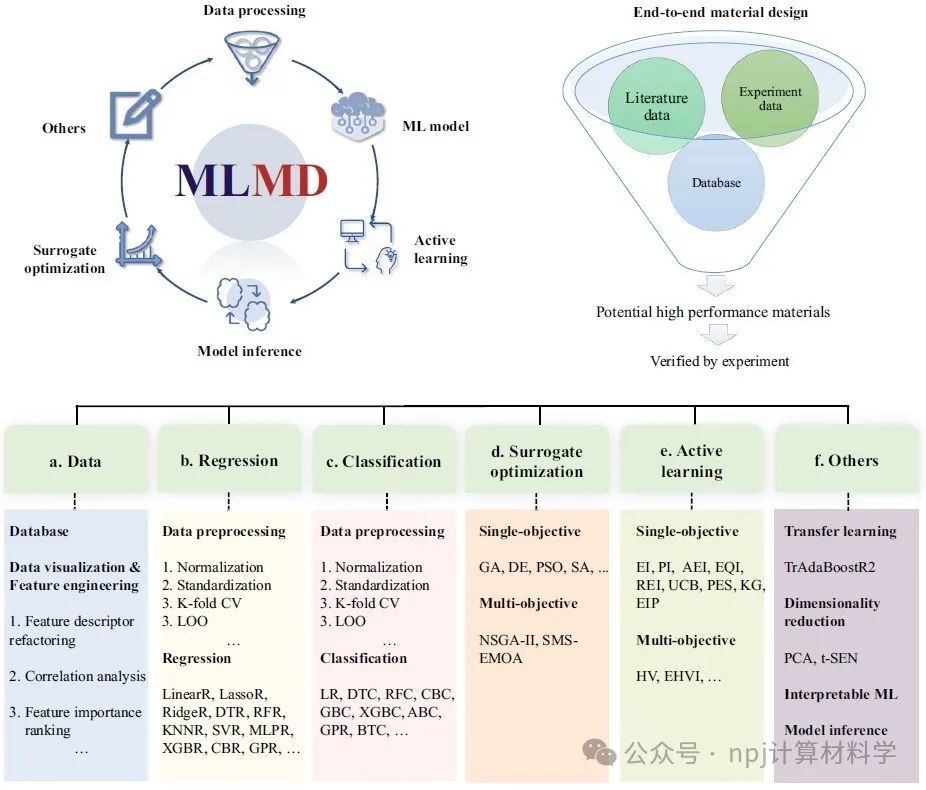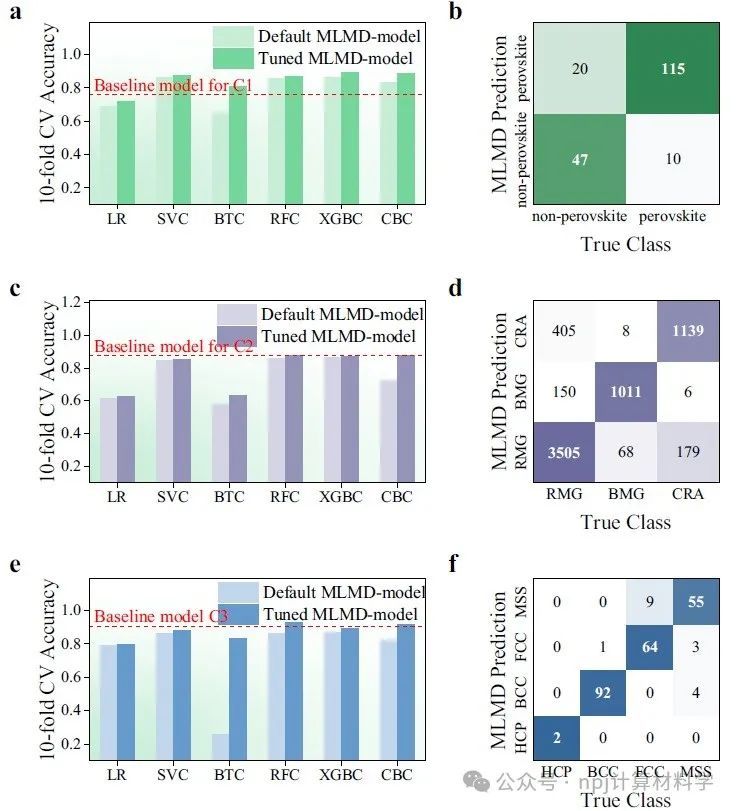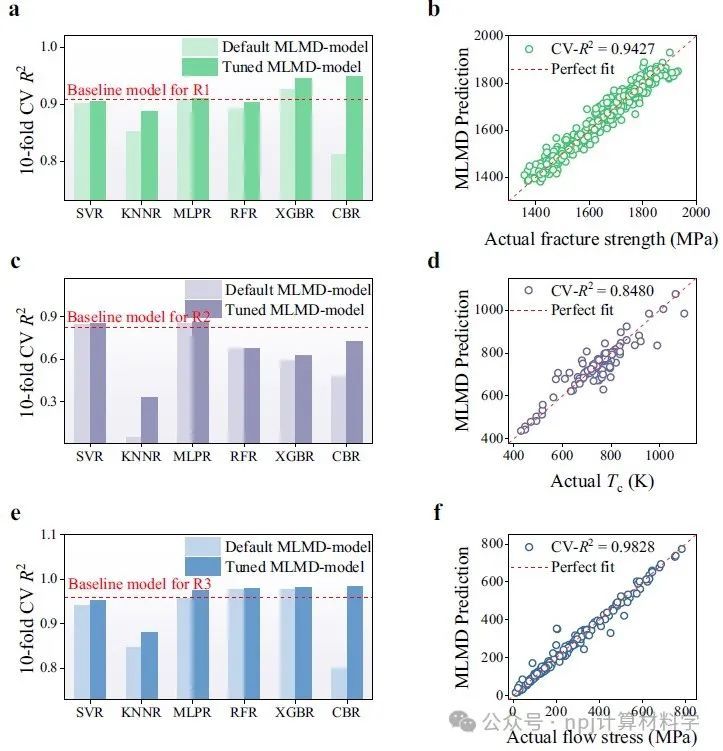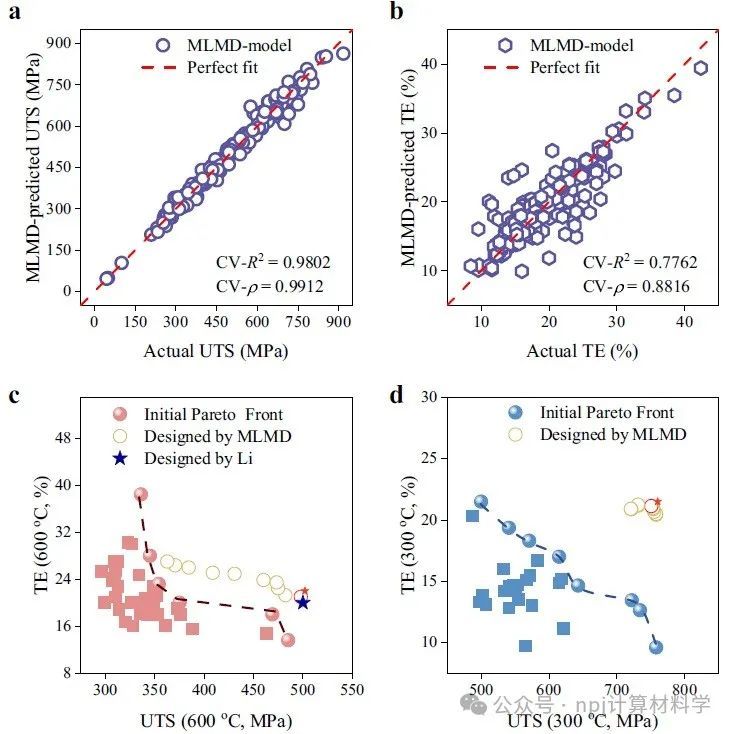材料基因工程的研发理念深刻变革了材料研发范式,提高了新材料的研发效率,降低了研发成本。材料基因工程研发理念的核心是材料信息学,人工智能技术是材料信息学的核心工具。

Fig. 1 Overview and architecture of MLMD.
来自上海大学材料基因组工程研究院的张统一院士团队,开发了MLMD (matdesign.top),一个面向材料设计的无需编程AI平台,平台可以实现材料的高通量筛选和代理优化,进行单目标或者多目标的材料设计。同时可以针对材料领域小数据问题,开发了基于贝叶斯的主动学习和基于迁移学习的无编程材料在线设计流程。

Fig. 2 | Flowcharts of materials design inMLMD platform.
MLMD平台包含了三个主要的材料设计流程:模型推理、代理优化和主动学习。模型推理和代理优化的效率取决于预测模型的鲁棒性,而模型性能则受限于可用数据的质量。在代理优化中,训练好的预测模型被集成到随机优化算法中,以加速材料设计。主动学习模块利用贝叶斯理论,平衡探索和开发,以制定最优的材料设计策略,推荐当前最优的材料参数。针对推荐参数开展新的实验或计算,不仅可以验证ML预测,还为数据集提供新数据,用于主动学习新一轮循环。

Fig. 3 | Cross-validation results of six ML models through classification module within our MLMD platform.
MLMD平台通过对6类材料数据开展的示例性研究显示,平台可以仅通过鼠标点击式操作的方式,完成材料的性能预测和优化设计。例如,在代理优化模块中,作者使用MLMD成功地设计出在300 ℃环境下强塑性优异的RAFM钢,其中抗拉强度723.1 MPa,总伸长率20.7%,抗拉强度与初始数据集相比提高了12.5%,总伸长率提高了41.4%。并且通过简单的超参数设置,可发现位于Pareto边界上的其他具有优异特性的材料,根据具体要求应用于多种场景。在主动学习模块中,作者基于自研的主动学习库(Bgolearn),使用了EI,REI和UCB等效能函数对高硬度的AlCoCrCuFeNi高熵合金进行了成分设计,所得的成分与原始工作中的成分相近,并提供了更多候选成分。

Fig. 4 The atomic percentage distribution of novel AlCoCrCuFeNi HEAs designed through active learning module in MLMD.
MLMD平台致力于将材料试验/计算与设计相结合,为科研人员提供前沿的机器学习工具,能够无编程利用材料信息理念下的材料设计流程,加速发现一种或者多种优异特性的新材料,MLMD有潜力成为科研人员在材料研发中不可或缺的工具,推动材料信息学的发展。本文共同第一作者是上海大学博士生马家轩和香港科技大学(广州)博士生曹斌,上海大学孙升研究员和熊杰助理研究员为共同通讯作者。相关论文近期发布于npj Computational Materials 10: 59 (2024)。

Fig. 5 | The RAFM steels design process through surrogate optimization module in MLMD.
Editorial Summary
To predict and design materials: A programming-free AI platform
Improving the efficiency of materials discovery is crucial for advancing modern industry. However, researchers often face challenges in navigating complex experimental processes, which can be time-consuming and labor-intensive. The emergence of artificial intelligence (AI) offers a promising solution to streamline this process. Despite numerous AI tools and platforms developed for materials science, they often have limitations, such as focusing solely on property prediction and being difficult to use without programming expertise, especially when dealing with limited data sets.

Fig. 6 | The atomic percentage distribution of novel AlxCoyCrzCuuFevNiw HEAs designed by Wen and MLMD.
A research team led by Prof. Tong-Yi Zhang from the Materials Genome Institute at Shanghai University has developed a programming-free AI platform called MLMD for materials design. This platform enables materials design by optimizing single or multiple properties through high-throughput screening and/or surrogate optimization. The challenge of limited data was overcome by leveraging active learning with Bayesian methods and surrogate optimization based on transfer learning.
Using the surrogate optimization module, the work successfully designed an advanced RAFM steel with an ultimate tensile strength (UTS) of 723.1 MPa and a total elongation (TE) of 20.7%. These properties represent improvements of 12.5% for UTS and 41.4% for TE compared to the original dataset. The MLMD platform can also identify other advanced materials on the Pareto frontier by adjusting hyperparameters. These new materials can be tailored for specific applications.
Within the active learning module, the team has developed a tool called Bgolearn, which is specifically designed for materials design. Using this tool, they have discovered a high-hardness AlCoCrCuFeNi alloy (HEAs) with a composition similar to that of previous work. This finding demonstrates the effectiveness of their approach in identifying new materials with desired properties.
MLMD is designed to integrate materials experimentation/computation with AI-driven design, providing researchers with a cutting-edge tool for programming-free materials discovery. This platform can accelerate the identification of new materials with specific or multiple properties. MLMD is poised to become an indispensable resource for materials scientists and will significantly advance the field of materials informatics.
The first authors of this study are Jiaxuan Ma from Shanghai University and Bin Cao from Hong Kong University of Science and Technology (Guangzhou). The corresponding authors are Prof. Sheng Sun and Assistant Professor Jie Xiong, both from Shanghai University.
This article was recentlypublished in npj Computational Materials 10: 59 (2024).
原文Abstract及其翻译
MLMD: A programming-free AI platform to predict and design materials (MLMD:一个无需编程的AI平台,用于材料性能预测和材料设计)
Jiaxuan Ma, Bin Cao, Shuya Dong, Yuan Tian, Menghuan Wang, Jie Xiong, & Sheng Sun
Abstract Accelerating the discovery of advanced materials is crucial for modern industries, aerospace, biomedicine, and energy. Nevertheless, only a small fraction of materials are currently under experimental investigation within the vast chemical space. Materials scientists are plagued by time-consuming and labor-intensive experiments due to lacking efficient material discovery strategies. Artificial intelligence (AI) has emerged as a promising instrument to bridge this gap. Although numerous AI toolkits or platforms for material science have been developed, they suffer from many shortcomings. These include primarily focusing on material property prediction and being unfriendly to material scientists lacking programming experience, especially performing poorly with limited data. Here, we developed MLMD, an AI platform for materials design. It is capable of effectively discovering novel materials with high-potential advanced properties end-to-end, utilizing model inference, surrogate optimization, and even working in situations of data scarcity based on active learning. Additionally, it integrates data analysis, descriptor refactoring, hyper-parameters auto-optimizing, and properties prediction. It also provides a web-based friendly interface without need programming and can be used anywhere, anytime. MLMD is dedicated to the integration of material experiment/computation and design, and accelerate the new material discovery with desired one or multiple properties. It demonstrates the strong power to direct experiments on various materials (perovskites, steel, high-entropy alloy, etc). MLMD will be an essential tool for materials scientists and facilitate the advancement of materials informatics.
摘要 先进材料的加速研发对包括航空航天、生物医药和能源问题在内的现代工业发展至关重要。然而材料研发的搜索空间巨大,所研发的材料占比极小。材料科学家们常常因为缺乏高效的新材料发现策略而陷入费时费力的试验过程。人工智能(AI)技术有望成为突破这一壁垒的关键工具,展现出巨大潜力。尽管目前已经出现了多个针对材料科学的AI工具包和平台,但它们仍存在不少局限性,例如过分侧重于材料性能的预测、对没有编程背景的材料研究人员不够友好,以及在数据量较少的情况下表现不尽人意等。为了解决这些问题,我们开发了MLMD——一个专注于材料设计的AI平台。MLMD整合了模型推理和代理优化技术,能够在数据稀缺的环境中通过主动学习和迁移学习的方法进行材料设计,能够高效地发掘性能优越的新材料。此外,MLMD还具有数据分析、描述符重构、超参数自动优化和性能预测等多项功能,提供了一个用户友好的、无需编程的Web界面。MLMD致力于将材料试验/计算与设计相结合,对各类材料(如钙钛矿、钢、高熵合金等)均具有强大的试验指导能力。我们坚信它将成为材料研究人员的重要工具,推动材料信息学的发展。










 上海大学的MLMD平台利用人工智能和材料信息学,通过模型推理、代理优化和主动学习,实现了高通量材料设计,显著提升研发效率。无需编程的界面使得材料科学家能轻松设计高性能材料,如RAFM钢和高硬度合金,促进了材料信息学的发展。
上海大学的MLMD平台利用人工智能和材料信息学,通过模型推理、代理优化和主动学习,实现了高通量材料设计,显著提升研发效率。无需编程的界面使得材料科学家能轻松设计高性能材料,如RAFM钢和高硬度合金,促进了材料信息学的发展。

















 被折叠的 条评论
为什么被折叠?
被折叠的 条评论
为什么被折叠?








